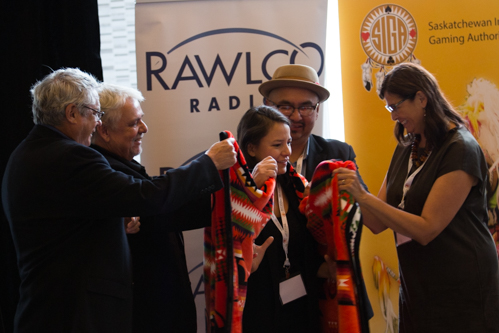Betty Ann Adam takes the Calls to Action of the Truth and Reconciliation Commission personally.
Besides co-chairing the organizing committee for the Reconciliation and the Media conference, Adam is helping to tell the story of her own family's experience with the Sixties Scoop in an upcoming National Film Board documentary.
She and her siblings were among thousands of Indigenous children placed in foster and adoptive homes from the 1960s to the 1980s. Like the Residential School era that preceded it, and to which Adam's mother was subjected, the Sixties Scoop removed children from their families, their communities and their cultures.
Adam is a member of the Fond du Lac Denesuline First Nation but was raised in a foster home in the Prince Albert area.
As an adult, she spent years seeking out her three siblings. She was the only one who got to meet their mother.
In 2015, after she'd found her two sisters and brother, Adam was planning their first ever gathering when she met TRC commissioner Dr. Marie Wilson, who encouraged her to document the event.
The idea appealed to Saskatoon filmmaker Tasha Hubbard who took the story to the NFB.
Adam said she is willing to share her private experience because it may educate others.
"I feel it is incumbent on me as an individual to do my part," she said.
"My family experience, I think, offers some insight for other people that I will never meet, who will see this film," she said.
In conjunction with the film's release, expected this spring, Adam will write about her experience for Postmedia and the StarPhoenix.
Adam got her start in print journalism working for Doug Cuthand in the late 1980s on the Saskatchewan Indian magazine.
"She's been an asset to our community," Cuthand said.
Adam says that as a young person trying to seek out her identity, she deliberately took work with Indigenous organizations.
Cuthand explained that one thing he and Adam have in common is they don't get culture shock when they see poverty-stricken communities.
"Betty Ann is the same way, she could go and meet Indian people and not have any kind of culture shock. She'd just fit right in and be able to get their story. That's very important."
In 1989, Adam was hired as a reporter at the Saskatoon StarPhoenix. A 1990 diversity survey of daily newspapers across Canada recorded only four aboriginal reporters among papers that responded.
Adam had been at the StarPhoenix for 26 years when she and four other Indigenous journalists began planning the conference. Adam was delighted when Marie Wilson agreed to give a keynote address. Having one of the TRC commissioners address the audience, especially when she a journalist herself, was very inspiring, Adam said.
"This conference is exceedingly important here in Saskatchewan where we have the greatest number of living survivors of Indian residential schools and where we have 72 First Nations and we're the homeland of the Metis," she said.
Adam hopes the conference and others like it will "change the way Canada relates to Indigenous people."
"I think reconciliation is all about all of us in Canada working together to figure out how do we move forward from this," she said.
Follow on Twitter: @CelineGrimard
















